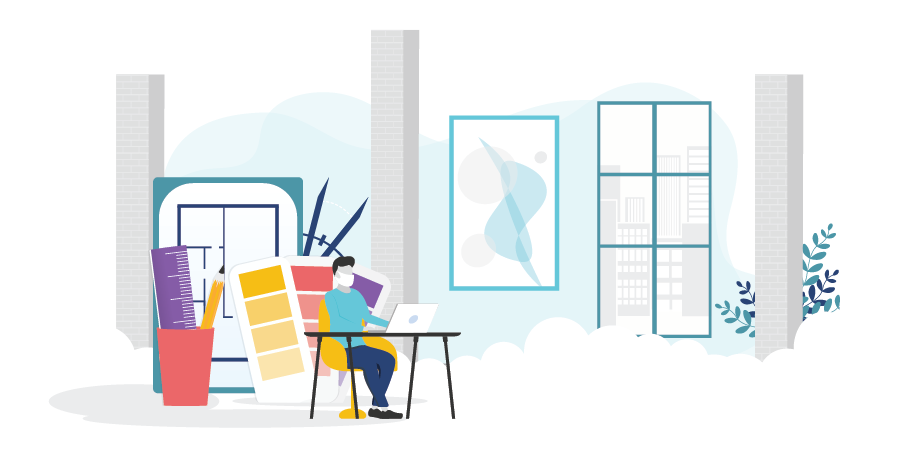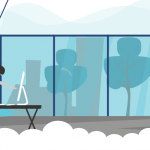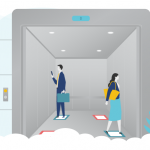The 10 Biggest Challenges Faced by Interior Designers During COVID-19
September 28, 2020
Interior Designers are used to being adaptable. Every project is unique, after all. And design jobs rarely go according to plan.
But the changing demands of COVID-19 might be moving faster than you can keep up. The pandemic has affected nearly all ongoing and planned design, development, and construction projects. Public health news, safety legislations, and OH&S laws are in constant flux, and with them, the needs of your clients.

What does interior design look like in a post-pandemic world? How will you balance your clients’ needs with public safety? How will you balance YOUR business needs with public safety? And most importantly, how will you protect your clients and your practice?
To help you out, we’ve put together a list of the biggest professional risks faced by Interior Designers during the COVID-19 crisis and what you can do to mitigate them.
Disclaimer: We know that you may have already undertaken extensive research to advise your clients. Please note that the information provided herein is presented from a liability-based perspective to avoid insurance claims. It is meant to supplement your existing research and is not exhaustive or a substitute for legal advice.
What are the challenges?
1. Contracts
Like many Designers, you may already have a contract template that is clear on the allocation or transfer of risk to all involved parties. However, the fast-moving nature of COVID-19 and uncertainty about its full extent makes project changes difficult to predict. Sudden disruptions in performance, schedule, or pricing may be unaccounted for under the existing terms of the contract, boosting the potential for client disputes, lawsuits, and claims.
Without clear contractual language, clients could hold you responsible for instances of virus transmission and any project suspensions or business interruptions that follow.
PRO Tips:
-
Don’t shake on it—handshakes, verbal agreements, and even invoices aren’t legally binding or foolproof enough to guard against a claim. Use a written contract for all engagements.
-
Don’t use generic online forms. Tailor your contracts to address the scale, scope, and needs of each project.
-
Explicitly define the current and anticipated future effects of the pandemic on:
-
Terms and conditions, including services to be provided (and not provided);
-
Price escalations, payments, and invoicing schedules;
-
The timing and delivery services;
-
What constitutes an “excusable delay”, parameters for notice of the delay, and how long the delay will be;
-
Termination rights, including termination for a prolonged delay;
-
All applicable health and safety procedures and how they are compliant with regulatory, provincial, and professional requirements;
-
Response protocols if your project is halted, shut down, or suspended in the future;
-
Crisis response protocols for positive cases;
-
Any privacy and confidentiality issues, threats to data security on all platforms, and safeguards in place to combat them. This is crucial if you are providing e-services.
-
-
Clearly distinguish between baseline and unanticipated conditions, particularly when setting timelines. A well-defined description of baseline conditions may be useful for clients to make sense of why there’s a delay.
-
Have a lawyer review all of your professional templates (with clients, subcontractors, and suppliers) and any clients’ contracts for existing and upcoming projects. Ask questions—make sure you understand your legal obligations. Amend your templates as needed to ensure you are adequately protected.
-
As a rule of thumb, do not auto-renew any contracts without seeking legal counsel for more than three years.
-
Do not act as your own lawyer under any circumstances.
-
A paper form is not a substitute for a discussion. Make sure your clients have a full grasp of your contract and ample opportunity to ask questions.
-
Ensure contracts are signed and dated by all relevant parties.
-
Be prepared to frequently review and update your contracts, advice, and deliverables as the situation changes.
2. Project Management
Every project will be uniquely affected by the pandemic. Broad approaches to risk allocation and crisis response that don’t acknowledge industry or project-specific issues may render performance substantially more difficult, expensive, or in some cases, impossible.
Depending on your role, you might face greater risk by assuming responsibility for:
-
Hiring subcontractors, consultants, and other professionals;
-
Installation, manufacturing, fabrication, and similar services;
-
Sourcing and buying fixtures and furnishings on behalf of your client;
If any of your services is impacted by COVID-19—be it a shutdown construction site, manufacturing delay, or supply deficits—you could be liable. And keep in mind: client expectations will generally be higher if you take on the role of Project Manager.
CASE STUDY:
You put in an order of plexiglass barriers with a supplier. With increased demand all-around, your supplier is unable to fulfill your order for at least another month. Your client is upset; they have to push back their business’s reopening and won’t generate enough revenue to cover the cost of another’s month’s rent. They file a claim, alleging that you are responsible for the rent since you placed the order.
PRO Tips:
-
Be knowledgeable about legislative, regulatory, and policy issues at provincial and municipal levels to see how it’ll alter the design and construction of critical infrastructure across the province.
-
Be aware of any sector-specific jurisdictional requirements for the industries you serve, such as variations in PPE and social distancing. (e.g. hospitality, corporate, and retail businesses will all have different needs).
-
Use scenario planning, careful analysis, and drafting to consider all conceivable circumstances and determine your approach to each project.
-
Seek legal counsel to determine whether or not a particular project or type of work can proceed depending on the stage of the crisis we are in.
-
Have a contingency plan in place in case your project(s) need to be halted, shut down, or suspended again. Include all business partners in your plans.
-
Be flexible. The true reach of the coronavirus is yet to be seen. It is impossible to know exactly what’s coming and how best to plan. Flexibility will be key in future planning.
3. Performance Issues
As an Interior Designer, you’re no stranger to stress. Between building inspections, developing drawings, managing budgets, and more, there’s plenty to tackle on your to-do list. But with ever-evolving pandemic dynamics, it’s easy to skip a step or make a mistake when you’re focused on making your client’s space as safe as possible. Especially if you’re juggling multiple projects at the same time.
What if supplier unavailability causes you to deliver fixture selections after a deadline? What if you write down the wrong measurement and place a bulk order of a product in the wrong size? What if you switch materials to comply with safety guidelines without telling your client and they’re unhappy with the final look?
Despite your best intentions, even a single error could trigger a claim. Even if your project is completed on-time, as-planned, to-budget, clients can sue as long as they think you’ve caused them financial harm or omitted important details.
CASE STUDY:
Earlier this year, you ordered custom furniture for a client’s home remodel. Because of COVID-19, your project was halted and your general contractor is no longer available when you resume operations. You quickly sign on a new contractor to finish the job but neglect to tell them that the furniture is to be wall mounted rather than floor mounted. As a result, the furniture must be reordered and reinstalled; your client accuses you of negligence and demands you cover the cost of replacement.
PRO Tips:
Documentation:
-
Maintain a full record of all provided services, actions, and interactions, including online correspondence and e-services. Inform clients that you will do so.
-
Don’t wait—try to document all actions immediately so the information is as accurate as possible. It might seem time-consuming, but it’ll come in handy in the event of a frivolous allegation.
-
Retain both physical and digital notes for your records.
-
Note: the time and date, all discussed topics and next steps, and any recommendations you made and why, along with the client’s refusal if applicable.
-
Treat client information with the utmost discretion and confidentiality.
-
Ensure that all documentation is objective—avoid personal opinions.
-
Verify all details before placing large orders with suppliers. If possible, have a colleague or partner look over your order before submitting.
Communication:
-
We will probably continue to see elongated timelines and project changes throughout the duration of the crisis. Be sure to keep all relevant parties (clients, subcontractors, suppliers, etc) informed of all modifications to:
-
Design plans and layouts;
-
Pricing and deadlines;
-
Government and safety protocols.
-
-
Communicate major changes in a timely manner. Note the time and date when you do so.
-
Be sensitive to issues of urgency when necessary.
-
Do not always assume understanding by the client or subcontractor or use industry jargon that either party may be unfamiliar with. Follow-up in writing through summary emails on any key information and decisions.
4. Design Services
COVID-19 has reshaped the way we view social spaces. With heightened sensitivity to touch, increased awareness of social distance, and a renewed focus on healthy environments, infection control is top priority.
As the crisis unfolds, Interior Designers have a vital role to play in public health. Whatever your area of specialty: clients are looking to you for guidance on how to design functional, comfortable, and safe homes and businesses. Common examples include:
-
Space Planning: Commercial spaces will require reimagined layouts and redesigned interiors that incorporate public health directives through larger rooms, wider hallways, and more.
-
Material Selection: Designers may be asked to specify materials for furniture, fixtures, flooring, high-touch surfaces, and everyday objects that are germ-resistant, non-porous, and/or smooth and easy to clean, sanitize, or maintain.
-
Healthy Spaces: Clients might be more interested in specialized products that reduce the risk of bacteria and germ build-up in their spaces, such as: air purifiers, indoor air quality monitoring, filtration systems for improved ventilation, auto-cleaning technologies, more hand washing stations and sinks, antimicrobial coatings, ultraviolet lamps, and more.
These requests could lead to:
-
Pricing Changes: Incorporating safety measures might make it difficult to work within the client’s budget or timeframe if there’s a shortage in high-demand materials. Often switching to a more hygienic product can even cause the project to go over budget.
-
Misinformation: You could be found negligent for failing to select safe materials if you’re not up-to-date on the latest policies and safety legislations for the jurisdictions and industry sectors you serve.
-
Property Damage: Budget-conscious clients might push you to retrofit existing furniture in accordance with safety protocols, like using storage cabinets or wardrobe lockers as dividers to maintain a 6 ft. distance. However, this could lead to a claim if any furniture or fixtures are damaged in the process.
- Products Liability: Interior Designers who custom design and sell products are vulnerable to products liability if there’s a defect in a product or service that causes damage or injury—even if it’s due to a client’s misuse. If a case of COVID-19 is traced back to a custom product you designed for a client, you could be sued.
CASE STUDY:
Based on information from your supplier, you suggest a particular antimicrobial coating to reduce the risk of surface transmission in a client’s office. However, you later learn that the material you chose is in fact not capable of mitigating the spread of COVID-19. Your client issues a letter demanding that you replace the desk and workspace materials since you recommended them.
PRO Tips:
-
Coordinate with tradespeople for technical expertise where appropriate, like Mechanical / Electrical Plumbing engineers for plumbing fixtures and HVAC upgrades.
-
Refer to reliable and accurate information before recommending any products. Document your rationale for doing so and any sources.
-
If any recommendations come from a supplier:
-
Always question the validity of any “facts” provided by the client or suppliers and do your own research to confirm.
-
Secure documentation from your suppliers to support any recommendations.
-
Have your client enter into a contract with a supplier directly. This ensures that the supplier will also have to respond in the event of a claim.
-
-
Avoid trendy furniture solutions that include soft, absorptive surfaces, with special attention paid to high-touch areas or areas with little space. For example, try to opt for laminate or vinyl in office cubicles that can be easily wiped down, rather than fabric panels, which are likelier to collect dust and trap bacteria.
-
With essential items taking priority, limited capacity of workers, and reduced hours of operation, supply chains are backed up. Source locally or domestically where possible to avoid or reduce the risk of manufacturing, distribution, or shipping disruptions to your project.
5. Management of Subcontractors
Be aware that the responsibility for all provided services remains with you, even if you’ve outsourced work to a subcontracted consultant or contractor (e.g. demolition, construction, design, installation). Chief risks to the management of subcontractors include:
-
Healthy and safety concerns (illness);
-
Significant labour or work disruptions (travel delays, delivery restrictions, etc.) which may impact the project schedule, quality production, and the efficiency of the work;
-
Potential contractor insolvencies as a result of COVID-19’s economic disruption.
If circumstances arising from COVID-19 hinder the ability of your subcontractors to perform, you might be hit with a lawsuit.
CASE STUDY:
Before the coronavirus struck, you hired a general contractor to complete elements of a Condo refreshment project. Months later, the Condominium Board discovers major deficiencies in the installation of wallpaper across the whole building. But due to the pandemic, the contractor has filed for bankruptcy and closed their business. The Condominium Board then sues you to recoup the funds because you hired the contractor to begin with.
PRO Tips:
DO NOT:
-
Assume the liability of subcontractors in client contracts.
-
Add on subcontractors as additional insureds to your insurance policy; your coverage will not apply.
-
Hire subcontractors without their own insurance.
DO:
-
Include indemnification / hold harmless clauses in contracts with subcontractors and suppliers.
-
Obtain certificates of Commercial General Liability Insurance from all subcontractors annually. Review these certificates in advance of a project.
-
Be aware of your subcontractors’ history, reputation, and financial stability, especially any new ones you’ve hired in the last few months.
-
Conduct a risk assessment of your sub-trade exposure, accounting for factors such as credit quality, supply chain resilience, and geography and jurisdictional conditions.
-
Monitor the financial condition of your subcontractor base on an ongoing basis. Be sure to evaluate the impact of COVID-19 on subcontractors’ other projects.
-
Again, documentation is critical. Record all schedule data, keep track of daily project logs, and note any complaints and issues your clients may have with subcontractors.
-
Communicate with your subcontractors openly, honestly, and regularly to understand the challenges they face and deploy effective risk management strategies.
-
Consider a liability waiver or a release form wherein the subcontractor acknowledges the inherent risk of contracting the virus by working on the project.
-
If your project must be halted, shut down, or suspended, review government orders to determine if your subcontractors are allowed to perform wind-down operations to protect existing work prior to closure.
6. Construction Worksites
All worksites that remain operational during the pandemic must adhere to government regulations regarding physical distancing, hygiene and sanitation, and PPE. Worksites are subject to inspection at any time and failure to comply may lead to investigations, fines, and/or criminal charges.
PRO Tips:
Be sure to:
-
Enforce safety protocols to protect the health and wellness of all involved and increase your inspection of worksites to ensure compliance.
-
Develop individual crisis response policies for all ongoing projects to meet the needs of each individual site.
-
If a client joins you onsite, have them sign a disclaimer form in which the client acknowledges the risk of contracting COVID-19 from the site.
7. Compliance Violations
Fees, fines, and penalties for compliance violations may arise from failure or liability to integrate safety measures with existing regulatory and legal requirements, such as accessibility standards and building codes.
For example, flat, smooth flooring like linoleum or vinyl is easier to clean, but might be too slippery when wet. Tiles with grains that add traction are more slip-resistant, but harder to clean once dirt gets stuck in the grooves.
CASE STUDY:
While designing a new restaurant, you are forced to compromise building code regulations to mitigate the spread of COVID-19. Upon inspection, the city building inspector requires the client to alter the restaurant’s layout in order to meet accessibility laws. Your client demands that you redesign the restaurant at no extra cost and cover construction expenses and all loss of revenue during closure.
PRO Tips:
-
Be proactive. Keep current with the news (government sites, public health) and routinely consult city websites for each project for updates on municipal orders or changes to project-related activities. (e.g. assessments, permits, building inspections).
-
Communicate any code deviations with the municipal building code officer. Detail why and any alternate steps you have considered.
-
Document all received approvals.
- In your client contract, specify that you are not responsible for any future costs related to building code requirements.
8. Enhanced Employer Risk
Whether you work out of an office space, a design studio, or your home, employers across Canada are obligated under various OH&S laws to protect employees and clients’ health and safety. Failure to do so can result in: workplace investigations, fines and penalties, and criminal prosecutions, if an employer knowingly exposed employees and clients to unsafe conditions.
As a Business Owner and an employer, you must adhere to strict workplace hygiene and physical distancing standards and provide safety training for staff. Until you can implement these safeguards, your business should remain closed.
Safety measures may not prevent COVID-19 transmission, but without them, employers face civil liability risk if an employee or a client contracts the virus through direct interaction with the business.
CASE STUDY:
A client visits you at your newly reopened offices. As a high-risk individual yourself, you’ve taken great care to ensure the office is fully compliant with all government orders and is as safe as possible. You have not been travelling, have no symptoms, and have been strictly following social distancing protocols. Nonetheless, within a few days of their visit, your client contracts COVID-19 and accuses you of being a carrier.
PRO Tips:
-
If you’re reopening your physical offices, consider having clients sign a liability waiver priority to entry acknowledging they will not hold you, your employees, or your business responsible if exposed to COVID-19 as a result of attending your facility.
-
For more information on how to safely and responsibly reopen and/or run your business, check out our online guides:
9. Increased Cyber Risk
Even before the outbreak of coronavirus, privacy breach was rising in frequency, intensity, and severity across the globe. According to the CIRA Cybersecurity Survey, 71% of Canadian businesses reported experiencing at least one cyberattack in 2018.
Small businesses are equally as vulnerable. Recent reports from the Ponemon Institute and Verizon show that despite their size, SMEs comprise roughly two-thirds of all data breaches.
With the majority of the world now working from home, opportunist hackers are capitalizing on global fears to prey on worried populations, disrupted workers, and struggling businesses. To learn more about why Interior Designers are at risk, click here.
In the event of a cyber breach, it’s not just the loss of data you have to worry about; there’s also regulatory fines under the PIPEDA Digital Privacy Act, legal fees, and business interruption costs. In fact, a data breach costs Canadian businesses about $6.35 million CAD on average.
Even worse? You won’t just lose your carefully curated design portfolios or your network of clients; you’ll lose their trust.
CASE STUDY:
An Interior Designer at your firm accidentally opens a malicious link from a phishing email, giving a hacker access to clients’ personal data. Since the Designer made a technology-related error, your general liability policies will pay damages to third-parties whose information was compromised, but they won’t cover the cost of client care, disciplinary fees, and regulatory investigations.
PRO Tips:
-
For practical, immediate steps on how to stay cyber-safe while working from home, click here.
-
Given the remote work revolution of COVID-19, telework is slated to become the expected employee norm in a post-pandemic world. Cybercriminals will adjust their tactics accordingly; you’ll need to be prepared. Be sure to invest in robust cybersecurity measures and allocate funds towards talent management, specifically IT talent acquisition, cybersecurity skills and training for all employees, and rewards and incentives encouraging staff to be vigilant.
-
If you don’t have existing cyber coverage, consider Data Security & Privacy Breach Insurance. A comprehensive policy can help offset some of the potential financial loss from legal fees, damages, and associated expenses. To learn more, click here.
10. Gaps in Coverage
You could be faced with the possibility of ceasing practice as a result of COVID-19. Whether it’s by choice (a leave of absence, maternity leave, early retirement) or involuntary (illness, unemployment, a temporary or permanent shut down) it might be tempting to cancel your insurance to trim your costs for the time being.
Here’s why that’s not a good idea: most insurance policies are claims-made. That means that the policy you have in place at the time an allegation is reported will respond, NOT the policy you had in place at the time you committed the alleged act. Any claims filed following the cancellation, expiration, or non-renewal of the policy won’t be covered.
Keep in mind: you can be served YEARS later, long after the event giving rise to the claim has taken place. If you don’t have insurance when the claim is reported, you won’t be covered for past work prior to cancellation.
PRO Tips:
-
Avoid gaps in your insurance coverage with an extended reporting period (ERP). An ERP keeps your policy in force for a specified period of time following cancellation or non-renewal. With a continuous policy in place, you’ll be covered whenever a claim is reported, even if you become inactive, go on leave, close your business, or retire.
-
PROLINK recommends continuous coverage for at least 6 years after you stop practicing.
The Best Practice: Customized Coverage for Interior Designers
Mistakes, accidents, and unpredictable clients are an inevitable part of doing business. That’s why the best practice of all—no matter what you do or who you work with—is insurance.
With nearly a decade of serving Interior Designers, PROLINK understands the unique threats you face like no one else. Our solutions are custom-tailored for Interior Designers registered with IDC or any affiliated provincial association—ARIDO, IDA, IDAS, IDIBC, IDNB-DINB, PIDIM—and will help you protect your business from risk, even if the claims made against you are groundless. Our comprehensive offerings include:
-
Professional Liability Insurance: Protects you (and your business) from allegations of errors, omissions, or negligence committed within the scope of your professional activities, including coverage for online and e-services. Click here to learn more!
-
Commercial General Liability (CGL) Insurance: Protects you from third-party claims of injury (including sickness or disease) and property damage caused by your professional activities or employee operations. Click here to learn more!
-
Data Security & Privacy Breach Insurance: Protects your digital assets and helps you get your business back online in the event of a privacy breach. Click here to learn more!
-
Property Insurance: Protects your Interior Design practice from damage and will cover the costs of repairs or replacement for contents, equipment, and furnishings.
To learn more, connect with PROLINK today!
PROLINK’s blog posts are general in nature. They do not take into account your personal objectives or financial situation and are not a substitute for professional advice. The specific terms of your policy will always apply. We bear no responsibility for the accuracy, legality, or timeliness of any external content.




